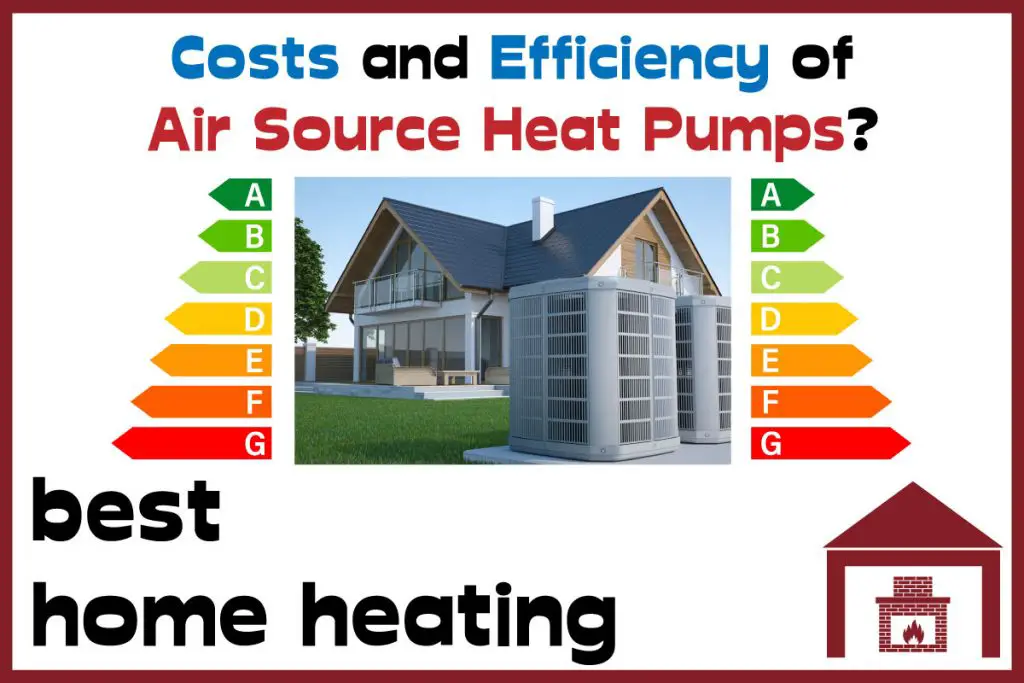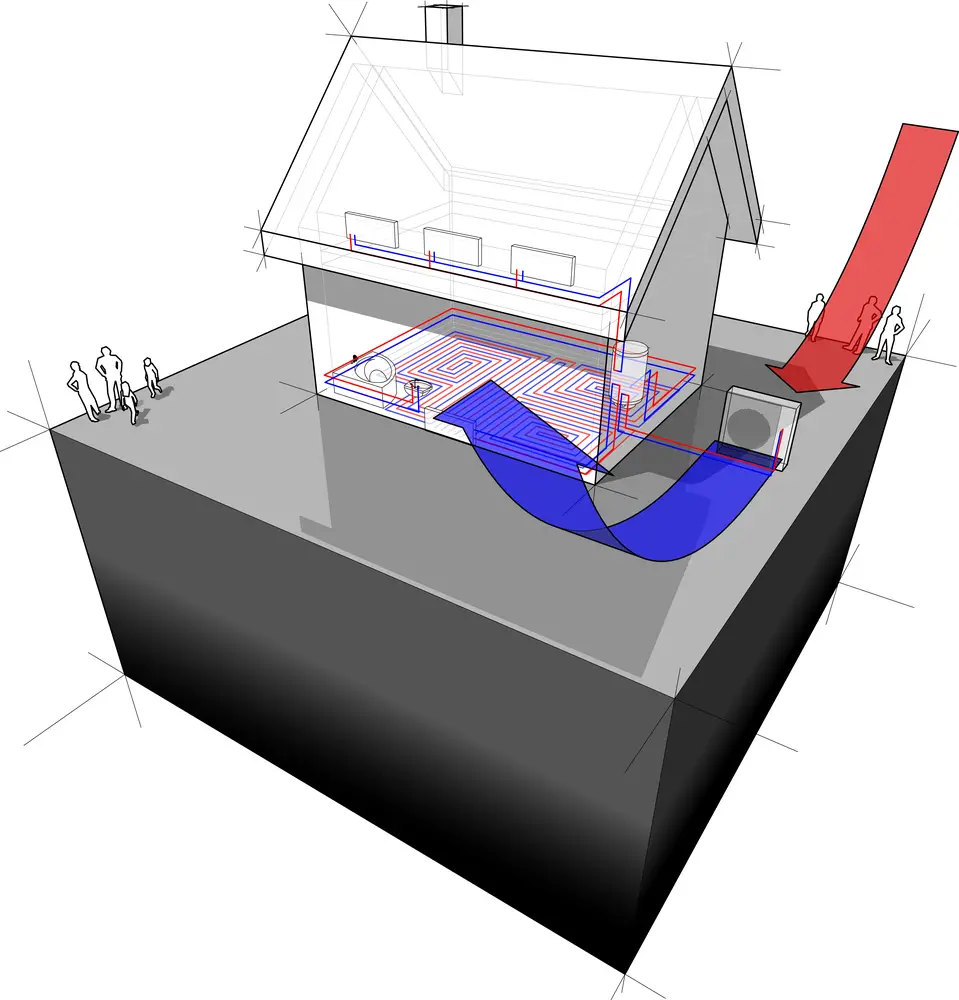Air Source heat pumps are a great source of heat production for homes. Before installing this system, it would be wise to research how efficient air source heat pumps are (all year round) and how much they cost.
Air Source heat pumps are very efficient heat sources for heating homes. On average, these systems possess a coefficient of performance (COP) of 3.2. This implies that for every 1KW of electricity that the system uses, 3.2KW of heat is produced. Conventional boilers tend to have a CoP of less than 1.
Although air-source heat pumps offer very good value for money compared to other heating systems, it would be best to have the necessary information regarding the pros and cons of this system.

How do Air Source Heat Pumps work?
An Air Source Heat Pump (ASHP) works in three basic steps:
- A network of tubes is filled with a refrigerant, and hot outside air is blown over them. During this process, the liquid refrigerant becomes a gas.
- The gas is compressed by a compressor, which increases the pressure. Adding pressure also adds heat, similar to how your tires warm up when you top off the air pressure.
- In a heat exchanger, hot, compressed gases are surrounded by cool air or water. By transferring its heat to this cool air or water, the refrigerant makes it warm. The warm air or water is circulated throughout your home to provide heat and hot water. At the same time, the refrigerant condenses back into a cool liquid and the cycle begins again.

ASHP units should be placed outdoors next to the property walls whenever possible. The main reason is that it is easier to service or maintain. The other important reason is that pipework should be kept to a minimum. If it is not possible to mount a unit on the ground, it can be mounted on brackets on the wall. In this case, ensure that it is not at head height and that it can be accessed when needed.
You cannot install an air source heat pump inside the house because it will effectively turn the room into a fridge. As long as it can extract no heat from the air around it, it will keep cooling the same air. You should also not cover the ASHP, as it will intercept the airflow in it.
Air Source Heat Pumps combine very effectively with water-based underfloor heating systems, as the two installations produce and use very similar water temperatures.
How energy-efficient are air source heat pumps?
Due to their outstanding SCOP (seasonal coefficient of performance), air-source heat pumps are efficient both in the winter and summer.
What is Coefficient of Performance?
The Coefficient of performance of a system is a ratio of the power input needed to produce a certain amount of energy at the output, with the output being heat for heat pumps. A ‘seasonal COP’ figure is adjusted to seasonality. The SCOP value takes into the effect of seasonal temperatures changes using the Seasonal Performance Factor (SPF).
An air-source heat pump, for example, operates at a COP of 3.2 when the outside temperature is above 7°C. Therefore, the heat pump is 320% efficient: it generates 3.2 kWh of heat for every kWh of electricity used for fans and compressors. The higher the coefficient of performance, the better its efficiency.
If you take the COP of an air source heat pump and compare it with the outside temperature, then you will find that they can run efficiently year-round despite some slight fluctuations. To compare heat pumps based on their impact on efficiency, the seasonal coefficient of performance is used.
When temperatures drop below 0°C, the COP can also fall to 2.5. Heat pumps have an average COP of 2.5-2.8, depending on the season. In mild climates, there are heat pump models that perform better.

How cost-efficient are air source heat pumps?
Installation costs
The cost of installing an air source heat pump is higher than installing a gas or oil-fired central heating system. Depending on the brand and heat output of the pump, the cost usually ranges from £4,000 to 8,000. Additionally, you’ll have to pay for installation. The total could be between £5,000 and $10,000.
Running costs
The two factors affecting the cost of operating an air source heat pump are highly interrelated:
- Heat requirement: Each property has a different heat demand, which describes how much heating power is required to maintain the correct temperature.
- Heat demand: The air source heat pump’s efficiency is determined by how much electricity it uses when it is heating a property
A heat pump can produce 3 kWh of heat from 1 kWh of electricity. In the case of an annual heating demand of 9,000 kWh, 3,000 kWh of electricity will be needed. With 3,000 kWh of electricity priced at £0.16 a unit in the UK, annual heating costs will be around £480
How do they compare to other types of systems?
As of 2020, gas costs about 4.65p per kWh, oil costs 4.82p per kWh, LPG costs 7.70p per kWh, and standard electric heaters cost about 20.06p per kWh in the UK according to EDF energy. An air-source heat pump costs about 5.73p per kWh to operate. So if your home has a gas connection, it might not be very economical to have an ASHP.

How does the timing of use affect cost and energy efficiency?
If the outside temperature drops below 5°C, remember to remove the ice that forms on the evaporator due to the moisture condensing in the air. Remove the ice from the coil and switch on ‘defrost mode’ by reversing the process. This will increase its efficiency by reducing its ability to transfer heat to the refrigerant. Turn off the evaporator fan and direct hot gas to the outdoor coil to melt the ice.
Although it isn’t mentioned on the manufacturer’s COP, removing the ice decreases the SPF (Seasonal Performance Factor) as well. As a result, you will minimize the amount of wasted energy and improve the heat pump’s efficiency by 5-10%.
Does turning ASHP on and off improve its efficiency
Heat pumps should never be completely turned off. When they are turned back on, they will try to raise the temperature as quickly as possible, which will be extremely expensive. The process of restoring the home to a comfortable temperature can also take several days.
- During the night: Set the room temperature to around 10-15°C, then slowly increase it in the morning so that the room is a comfortable temperature when you wake up.
- If you’re going away for a day, you can leave the system running.
- Going on vacation for a week: Your system should have a setting for ‘holiday mode’ or ‘frost protection’ that will automatically lower the temperature while you are away. If you go away during cold weather, this will also keep the pipes from freezing.
- You can either turn down the thermostat in the summer or use your heat pump’s ‘summer’ mode. It will not turn on the heating, but the hot water will still be available. As autumn approaches, the heating temperature can be raised slowly again.
Are ASHPs classified as green and renewable energy?
ASHP uses the warmth of the air outside (even when it’s freezing outside) to warm the home. Air source heat pumps are a type of renewable energy system. Other heat pumps do the same thing using ground heat and water heat, but air source heat pumps are suitable for a wider range of properties.
The heat pump itself may be powered by electricity which may or may not come from a renewable source, but since the air (or ground, or water) is heated by the sun, the energy it produces is still considered ‘renewable’. If you are generating electricity from solar panels, obviously ASHP would work as a sustainable and renewable energy source.
Are ASHPs still efficient in winter and cold weather?
In cold temperatures, your heat pump will not be as efficient as it would be in milder temperatures. It may be necessary to use more electricity to remove the heat from the air, resulting in lower efficiency.
A heat pump could achieve 3.8 CoP at an outdoor temperature of 8.3 °C. Your heat pump’s efficiency may drop to 2.3 CoP if the temperature drops to around -8.3 °C. The heat pump may need a backup if the outdoor temperature drops too low for it to produce any heat.
The lowest operating temperature for ASHP may vary. It is usually around -22 °C for most types of models.

Conclusion – Summary of Efficiency of ASHPs (cost and energy)
When the outside temperature is above 7°C, an air-source heat pump operates at a COP of 3.2. The heat pump is therefore 320% efficient. It may be necessary to use a backup heat pump if the outdoor temperature drops too low for the heat pump to function.
Heat pumps should never be turned off completely. Upon turning them back on, they will try to raise the temperature as quickly as possible, which is extremely expensive.
